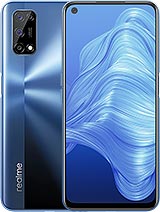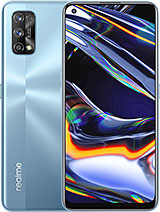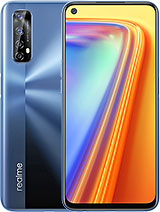Realme 7 full review By GSMArena Official
Hey everyone with all real me's releases. It can be a little confusing to tell which one of their phones you should buy if any. This hasn't gotten any easier with the release of their 7 series, which is more of an upgrade to their 6 series rather than a complete evolution. We've already covered the realm 7 pro, so, if you're interested in that phone there's a link down below, but if you're more interested in the cheaper sibling. Well, what exactly is the deal here? I'm Andrew for GST, marina- and this is our review of the realm 7. Like most realm phones.
The 7 has a clean look with captivating colors. The plastic back panel has a gorgeous split, mirror blue color and the long quad camera setup in the corner. It's a frosted finish, which means that it's better looking than a glossy one. It doesn't pick up fingerprints easily, and this one in particular is easier to handle because of a better grip. The phone weighs 197 grams, and it's a bit thicker and heavier than the Realme six likely due to the bigger battery.
Still it's very comfortable and secure in the hand where it isn't secure is anywhere around water. This phone has no increased water resistance, IP rated or otherwise advertised. So you should be careful even in the rain scratch. Resistance is hopefully better with the gorilla glass 3 protection on the front actually on the front, you'll find a rather standard setup, there's a hole punch in the upper left corner and a sliver of an earpiece on the top bezel. There's no notification led, which is no surprise, because the bezels are quite slim on the right side of the phone you'll find the power button which doubles as a fingerprint reader when it works it's fast, but like all side readers, it's also easy to block it with too many false unlock attempts caused by accidental reads when you're just handling or carrying the phone on the left side of the phone.
There's a try card slot for two sim cards and a micro SD card just in case the base.64 gigabytes of storage isn't enough for you, but you can also opt for 128 gigabytes of base storage. Just like our phone. The screen is the same as on the six: it's a 6.5 inch IPS LCD with a 1080p resolution, and we're really happy that it still comes with a 90 hertz refresh rate. Actually, this is a rather premium display for the budget sector, especially when you take the refresh rate, the large size and the good pixel density into account. Brightness was good too, and we got a max of 457 nits in manual mode and 526 nits in auto at its lowest brightness.
It got 3.8 nits, so it should be comfy to use in the dark too. As far as colors are concerned, there are no correction options, so what you see is what you get they're lively but not accurate, and we found that whites and grays shifted visibly towards blue. The phone has a single loudspeaker on the bottom, alongside 3.5 millimeter headphone jack. While we're happy to see the legacy port, the speaker was rather average. It had very good loudness in our tests and while vocals were handled well, lower frequencies were lacking, the phone comes with a MediaTek hello, g95t chipset and either four six or eight gigs of ram.
It's basically the overclocked version of the hello g90t and the Realme six. We had the highest spec option for testing in general. This is a very capable chip for the class, and you'll have lag free performance, not to mention very few games actually take advantage of that high refresh rate screen, so usually it won't be pushed to its limits. As far as competition goes, it's not hugely different from the six and tests, so this shouldn't be a huge differentiating factor. If you're deciding between the two, where you will find a bigger difference, is battery life.
The Realme 7 has a huge 5 000 William hour battery, and it scored an excellent 126 hours of endurance. This is actually a significant improvement on the 6, which scored a rating of 20 hours less on our tests. Charging was also excellent, and we got a 50 charge in 26 minutes and a full charge in 65. This is a bit slower than the 6 which got a full charge in 51, but the battery size is much larger here. The Realme 7 has android 10 with real me: UI 1.0, the launcher is minimalistic, and it looks similar to vanilla, android, there's an easy-to-use task, switcher, a dark mode, a clutter, free, app drawer, and there are even some customization options. You can choose between different icon packs and fully customize them to your liking.
You'll also find a smart sidebar on the edge of the screen, which you can customize with actions and app shortcuts. As someone who's been using realm's previous UI for a while, I often forget it's there, but it's still a nice option to have so now. How is the quad camera set up? Well first, you should know that if you're in Asia, you get a 64, megapixel quad bear primary sensor and if you're in the rest of the world, you get a 48 megapixel quad Bayer one other than that. The ultra-wide the macro camera and the depth sensor are identical between the two models. We'll be talking about the 48 megapixel version from here on out the phone, outputs, 12 megapixel images by default, and we found that the quality was a bit inconsistent.
When snapping camera samples, we usually take four shots of a scene, and here the first photo was always over sharpened, with a more limited dynamic range and the ones after were too soft. If you choose to take just one photo, you'll always get the over sharpened one. During the day, the resolved detail was nothing impressive, but enough for the class colors were warmer than in reality, and we saw noise in areas of uniform color like the sky. If you decide to zoom in with the two times or five times, toggles you'll be getting a purely digital zoom it'll be enough for social media, though portraits were very good for the class, with competent subject, detection and convincing background blur ultrawide shots are also very good, with a wider than usual dynamic range. Thanks to the auto HDR contrast was nice too.
Colors are lively, though warmer than they should be, and detail is in line with other ultrawide snappers in its class. The macro camera has a fixed focus, so you should be four centimeters away from your subject. It didn't capture very detailed shots and the photos are a bit dull in low light. The main camera captures shots that look good overall and had nice contrast. Exposure was okay, but we saw quite a bit of noise, even with the noise reduction on.
We did see more detail than expected, though, which is nice night mode on the main. Camera dramatically, improves everything, and we saw more detail: less noise, better colors and better contrast. Sure you'll have to wait three seconds for every snap, but seriously it'll be worth it in low light. The ultrawide should only be used in extreme cases since you'll be getting underexposed shots with a lot of noise and very little detail. If you switch on its night mode, you'll get brighter and less noisy shots, but the photos are still pretty mediocre.
The Realme can capture footage at up to 4k at 30fps with the main camera, while the ultrawide is limited to full HD at 30fps 4k shots don't have the realm 7 pros for stabilization, so they're rich in detail and have excellent dynamic range and great contrast. Colors are a bit reddish, though you can switch on the stabilization if you're shooting full HD videos, but while it works well, it ruins the video quality of the ultrawide camera. The 16 megapixel quad, Bayer camera takes decent selfies with enough light. You'll get good results with nice colors and contrast, though detail is just alright portrait mode. Selfies are outputted in 4, megapixels, and they're surprisingly, good they're nicely detailed and have proficient blur and separation.
Skin tones were good, too spoiler alert. At this point, you have probably realized that the Realme 6 and the Realme 7 are practically identical. Aside from the 7, slightly bigger battery the overclocked CPU and a different main camera sensor in some markets, oh and the paint jobs are also different. If you have the Realme six, there is no reason for you to upgrade to the Realme seven. If, however, you're coming from a different phone, then those small upgrades might be enough to push you to the realm 7 camp, especially if you're in Asia, where there is no camera downgrade in places where the 48 megapixel version of the phone is sold, though we'd actually stick with the realm 6 as our primary choice.
If its available thanks for watching everyone, stay safe, and I'll, see you guys next time, you.
Source : GSMArena Official



























